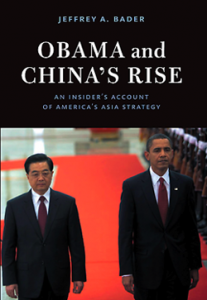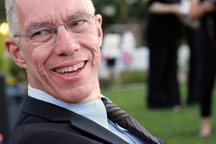 Review by Donald Camp
Review by Donald Camp
Obama and China’s Rise: An Insider’s Account of America’s Asia Strategy by Jeff Bader, Washington, DC: Brookings Institution Press, ISBN-13: 978-0815722427, 2012. 171 pp., $17.95
Obama and China’s Rise is a thorough and well-written description of and rationale for the administration’s approach to East Asia from January 2009 to April 2011. Author Jeff Bader deals comprehensively with China, while not neglecting developments in Japan, Korea, and Southeast Asia.
The subtitle says it better than the title. This is An Insider’s Account of America’s Asia Strategy. Bader clearly had the president’s ear on Asia policy. With Obama from the beginning of his campaign, Bader headed the Asia/Pacific transition team and became the senior East Asia policy maker in the White House. Thus, this is the first account of foreign policy making in the Obama administration written by someone who was actually there.
We already know from Bob Woodward (“Obama’s Wars”) and Ron Suskind (“Confidence Men”) that there was no shortage of internecine, bureaucratic warfare in both the National Security Council and National Economic Council in the Obama White House. Bader doesn’t go that route. While he discusses interagency differences in approach, he doesn’t personalize the policy issues.
Bader begins with the new administration’s priorities, one of which was to engage more actively with multilateral organizations. Thus, one of Bader’s first initiatives, in cooperation with Secretary Clinton, was to reverse the Bush administration’s refusal to adhere to an ASEAN treaty of amity; they argued, to a skeptical bureaucracy, that the treaty would not limit American options in Asia. Treaty accession provided the basis to allow the US, a year later, to join the East Asia Summit — a new mechanism through which to engage the region. Obama also resolved to meet annually with all the leaders of ASEAN, deciding that high-level engagement should not be held hostage to Burma’s presence in the organization.
Dealing with China provided some of Bader’s biggest challenges. Obama’s campaign rhetoric was restrained, avoiding the problem of past administrations that had to overcome the legacy of harsh partisan language on China (recall Clinton’s denunciation of coddling the “butchers of Beijing”). At Bader’s suggestion, Obama chose as ambassador Jon Huntsman who knew and respected China, and had studied Mandarin.
Once in office, the administration found a China that was newly assertive, especially in its territorial claims in the South China Sea, its challenges to U.S. naval ships, and its unhelpfulness on the Korean peninsula. Bader lays out the dispute within the Chinese leadership between the cautious foreign policy approach initiated by Deng Xiaoping in 1979 and the more assertive approach championed by the new leadership. He maintains China returned to the Deng approach by 2011 after seeing unhelpful trends in its neighborhood — Korea and Japan growing closer to the U.S., Southeast Asian nations becoming anxious about Chinese aggressiveness in the South China Sea, and Obama’s warm reception on his own trip to the region earlier that year.
When Bader argued successfully to postpone the Dalai Lama’s meeting with the President until after Obama’s November 2008 trip to China, he and the administration became the target of strong criticism from members of Congress and the press for seeming to kowtow to Beijing. Hard-line American critics of China put Bader in their appeasement camp, a “panda-hugger.” On the contrary, he and the administration in this telling take a clear-eyed approach that has no illusions, asserting traditional rights of navigation in China’s EEZ, continuing the sale of advanced weapons to Taiwan and ratcheting up pressure on China’s problematic trade practices. Bader’s own guiding principle was to “maintain America’s strength and watchfulness…without falling into the classic security dilemma wherein each side believes that growing capabilities reflect hostile intent…and produce that reality.”
Korea was another major focus of the NSC’s attention. North Korea’s provocations – nuclear and missile tests, the sinking of a South Korean naval ship, and the shelling of border areas – needed a strong response and, often, Chinese cooperation. Close coordination with Seoul, joint military exercises, and going to the UN Security Council seemed to be programmed responses by the U.S. government to all such developments. So were sharp words with Beijing to convince the leadership to confront North Korea on these issues, lest regional peace and good relations with the U.S. and with China’s East Asian neighbors be put into jeopardy.
When North Korea captured two U.S. TV journalists, the U.S. dispatched Bill Clinton (over Bader’s opposition) to Pyongyang to gain their release. The administration stressed to Clinton that he needed to take a tough line. As Kurt Campbell told him, “channel your inner Dick Cheney.” Clinton played it just right, pretending not to hear Kim Jong-il’s repeated invitation to attend a ritual mass exhibition before 100,000 spectators. Finally, Kim said, according to Bader’s (presumably second-hand) account, “Don’t worry. I can give away the tickets.”
Bader’s final months of his two-year term at the NSC were devoted to handling the administration’s response to the multiple disasters (earthquake, tsunami, and nuclear melt-down) in Japan. The book describes the substantial U.S. relief effort, the confusing information of the early days, and the priority given to protecting American citizens in Japan. The last task involved tough decisions about the U.S.-recommended evacuation zones; the provision of iodine pills to U.S. citizens, and whether to offer voluntary departure to official dependents in Tokyo.
Finally, personalities: Bader has “profound admiration” for the President, who he first met in 2005 and found to be a man who could – and should – be president one day. He is honest about his early skepticism of Hillary Clinton whom he initially saw as a mere dynastic successor to her husband. He admits his mistake as soon as he takes his first trip with her to Asia where he finds her “tireless, a rock star,” and invariably gracious, warm and inclusive. He has similarly kind words for his colleagues at State and the NSC, including Dennis McDonough, Mark Lippert, Dennis Ross, Jim Steinberg and Bader’s boss Tom Donilon.
Bader himself comes across as a dedicated team player, non-partisan in the best sense. His success came in part because he did what the staff of the NSC is supposed to do – be an honest broker coordinating the foreign policy agencies of the U.S. government with the goal of implementing the policy of the President.![]()
[Book editor’s note: The reviewer worked with the author for a period of about four months in the early part of the Obama administration.]
American Diplomacy is the Publication of Origin for this work. Permission to republish is freely granted with credit and a link back to American Diplomacy

